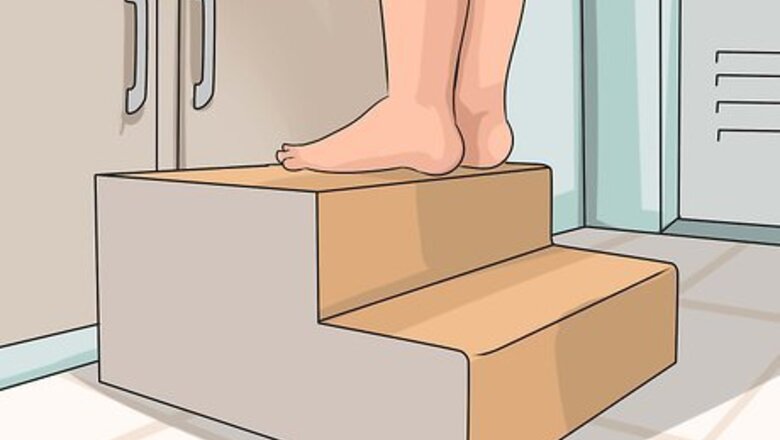
views
Preparing to Wash

Build a safe work zone around the sink and/or dishwasher. Start by providing a step stool or step ladder for your child, that way he or she can safely and securely reach the dishes in the sink. Also, all sharp and fragile objects should be removed to prevent any possible accidents. Finally, you may also want to line the sink and floor with towels to collect any spills that may happen. These steps will help ensure that your child is safe while washing the dishes. A step stool or step ladder can be purchased online, in hardware stores, or in children's department stores. Once on the stool, your child's mid-section should be level with the sink. The stool should be safe and secure. You might consider washing the knives and fragile dishes in front of your child, explaining how you are washing them and that soon it will be their turn to wash. Be sure to place them out of your child's reach once they are cleaned and dried. Any towel will work to absorb spills, but be sure to have plenty on hand in case of accidents.
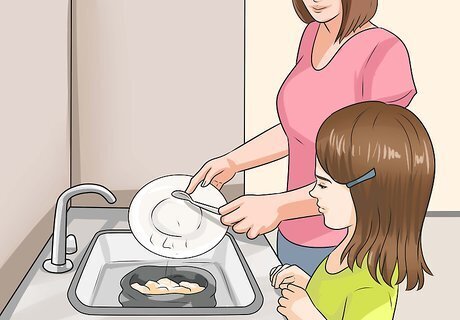
Begin by scraping the plates. This will remove excess food to allow easier cleaning later. Explain to your child that larger pieces of food will block the drain of the sink or dishwasher, so this food must be discarded before you can begin cleaning with soap and a sponge. There are several ways you may want to discard left over food, including in the trash, the garbage disposal, and by compost. If you are putting left over food in the trash, use a fork or knife to push the food off the plate into the trash. Be sure to show your child what you are doing and allow him or her to scape his or her plate. If you have a garbage disposal, show your child how to put leftover food in it safely. Instruct them as to what can and cannot be put into the garbage disposal, and that cold water should be running at all times when the garage disposal is running. If you compost, teach your child the food that can be used for composting and those that cannot. That which can be used should be saved, and that which cannot should be discarded.
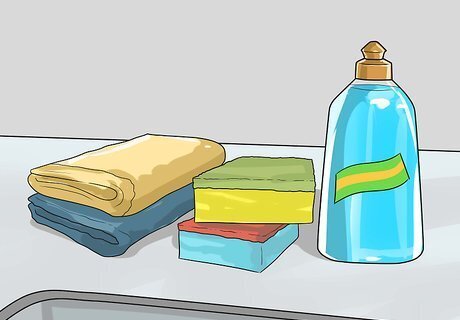
Prepare the necessary tools for washing the dishes. You'll need warm water, dish soap, two sponges and two towels. For more difficult dishes, you can use plastic scrubbers or steal wool pads. You may also want to use rubber gloves. You may want to collect warm water in the sink and add soap to it. Alternatively you can place a rubber bin in the sink to collect warm water, and then add soap to it. Lastly, you can leave warm water running from the faucet and add soap to dishes individually. All of these supplies can be picked up at a local supermarket. For a fun activity, have your child add soap to the water. He or she will surely enjoy the bubbles!
Cleaning by Hand

Begin by cleaning your glasses, plates and bowls. These are typically the least dirty of all the dishes, so its a good idea to start your child off by cleaning these. First, instruct your child to submerge the dirty glass, plate or bowl into the soapy water or under the running water. Next, have your child remove the object from the soapy water and scrub it clean with the sponge, adding more soap if necessary. Finally, have your child rinse the object with clean water, stacking cleaned, rinsed objects beside the sink. With younger children, it is always a good idea to demonstrate how to do the above steps before asking them to do it for themselves.

Clean the cooking dishes next. These are often more dirty, with stains and leftovers that are much more difficult to scrub off. Again, begin by helping your child submerge the cooking dishes into soapy water. Next, instruct your child to remove the object from the soapy water and scrub it clean with the sponge, adding more soap if necessary. Have your child rinse the object with clean water, stacking cleaned, rinsed objects beside the sink. Remind your child that the cooking dishes can be very dirty, so extra scrubbing may be necessary. You can use plastic scrubbers or steal wool pads if necessary.
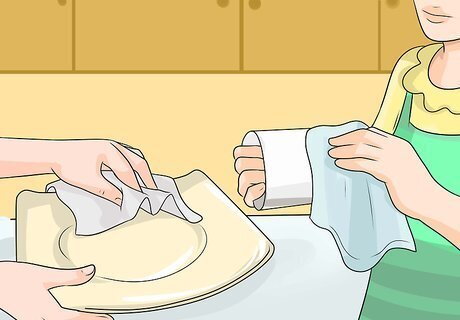
Dry the dishes. Once all dishware and cooking dishes have been washed and rinsed, its time to instruct your child how to dry. Make sure the drying towels are clean, and if they become too damp while drying, use a second towel. When everything has been dried, show your child where clean plates, glasses, pots and pans are placed.
Using a Dishwasher
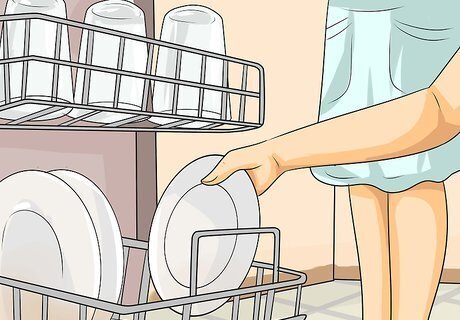
Load the dishwasher with pre-rinsed plates. Dishwasher drains can be blocked by excessive food, and food left on plates can remain stuck even after going through a cycle. If your home has a dishwasher then, after the initial rinsing and before scrubbing have your child assist you in loading the dishwasher. Instruct your child on how to maximize space in the dishwasher by lining up plates properly. Make sure that plates are not placed too close together, otherwise they may not get clean. For older children who can handle sharp objects, teach them that sharp knives should be placed so that they always face downward.
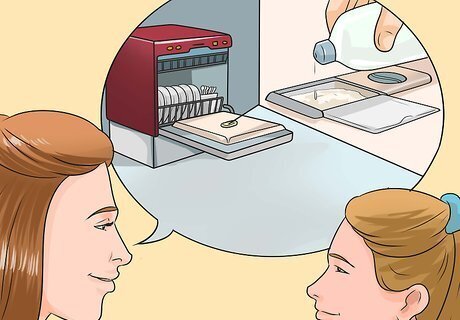
Instruct your child how to put soap in the dishwasher and how to begin the wash cycle. Soap is usually added to a dishwasher on the inside of the door, though this varies from model to model. It is important to instruct your child how to close and lock the dishwasher door properly after loading. The plate racks need to be pushed in before the door is closed. Once the doors are closed and locked, show your child how to run with wash cycle.

Complete the wash cycle. Once the dishwasher has finished cleaning the plates, show your child how he or she can tell that the cleaning has stopped. The is usually indicated by a light or beeping noise. From there, you can show your child how to unload the clean plates, glasses, pots and pans. Help your child put the clean objects back where they belong, and celebrate a job well done together. EXPERT TIP Wits End Parenting Wits End Parenting Parenting Specialists Wits End Parenting is a parent-coaching practice based in Berkeley, California specializing in strong-willed, “spirited” children with impulsivity, emotional volatility, difficulty “listening,” defiance, and aggression. Wits End Parenting's counselors incorporate positive discipline that is tailored to each child’s temperament while also providing long-term results, freeing parents from the need to continually re-invent their discipline strategies. Wits End Parenting Wits End Parenting Parenting Specialists Expert Trick: To get your children to help out more around the house, start by integrating a family work time. For instance, you might have 15 minutes on Saturday morning where you put on good music and everyone works together to clean out the refrigerator. Having kids help with household tasks gives them the perspective that the family is a cohesive group, and everyone's in it together.












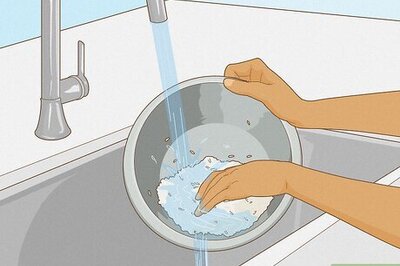




Comments
0 comment